Sita
Sita(Sanskrit: सीता; IAST: Sītā, Sanskrit pronunciation: [ˈsiːtaː]) is the central female character and one of the central figures in the Hindu epic, Ramayana and its other versions. She is described as the daughter of the earth goddess, Bhūmi or Prithvi and the adopted daughter of King Janaka of Videha and his wife, Queen Sunaina. She has a younger sister, Urmila, and the female cousins Mandavi and Shrutakirti.[6][7] Sita is known for her dedication, self-sacrifice, courage and purity.
| Sita | |
|---|---|
.jpg) Sita in exile by Raja Ravi Varma | |
| Devanagari | सीता |
| Sanskrit transliteration | Sītā |
| Affiliation | Avatar of Lakshmi, Devi, Panchakanya |
| Texts | Ramayana and its other versions |
| Festivals | Sita Navami, Janaki Jayanti, Vivaha Panchami, Diwali, Dussehra |
| Personal information | |
| Born | |
| Parents | Janaka ( adoptive father) Sunayana (adoptive mother ) Bhudevi (spiritual mother) |
| Siblings | Urmila ( sister) Mandavi (cousin) Shrutakirti ( cousin) |
| Consort | Rama |
| Children | Lava (son) Kusha (son) |
| Dynasty | Videha (by birth) Raghuvanshi-Ikshvaku-Suryavanshi (by marriage) |
| Part of a series on |
| Vaishnavism |
|---|
 |
|
Holy scriptures
|
|
Sampradayas
|
|
Related traditions |
|
|
Sita, in her youth, chooses Rama, the prince of Ayodhya as her husband in a swayamvara—bride choosing the best from a crowd of suitors after a contest, where Rama proves his heroism and valor and martial power and "defeats" the other seekers for Seeta's hand in marriage. After the swayamvara, she accompanies her husband to his kingdom, but later chooses to accompany her husband, along with her brother-in-law Lakshmana, in his exile. While in exile, the trio settles in the Dandaka forest from where she is abducted by Ravana, the Rakshasa king of Lanka. She is imprisoned in Ashoka Vatika in Lanka until she is rescued by Rama, who slays her captor. After the war, in some versions of the epic, Rama asks Sita to undergo Agni Pariksha (an ordeal of fire) by which she proves her purity before she is accepted by Rama, which for the first time makes his brother Lakshmana get angry at him.
In some versions of the epic, the fire-god Agni creates Maya Sita, who takes Sita's place and is abducted by Ravana and suffers his captivity, while the real Sita hides in the fire. During the Agni Pariksha, Maya Sita and the real Sita exchange places again. While some texts say that Maya Sita is destroyed in the flames of Agni Pariksha, others narrate how she is blessed and reborn as the epic heroine Draupadi or the goddess Padmavati. Some scriptures also mention her previous birth being Vedavati, a woman Ravana tries to molest.[8] After proving her purity, Rama and Sita return to Ayodhya, where they are crowned as king and queen. One day a man questioned the purity of Sita and in order to prove her purity and maintain the unquestionable dignity of Ayodhya kingdom and King Rama, she decides to leave the kingdom and sacrifice her place. Rama gave order to Lakshman to drop Sita in the forest near sage Valmiki's ashram. Years later, Sita returns to the womb of her mother, the Earth, for release from a cruel world as a testimony of her purity after she reunites her two sons Kusha and Lava with their father Rama.[9]
Etymology and other names
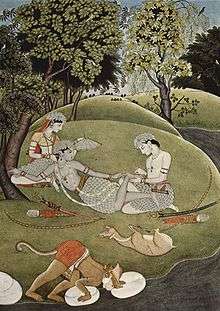
The goddess is best known by the name "Sita", derived from the Sanskrit word sīta, furrow.[10]
According to Ramayana, Janaka found her while ploughing as a part of a yagna and adopted her. The word Sīta was a poetic term, its imagery redolent of fecundity and the many blessings coming from settled agriculture. The Sita of the Ramayana may have been named after a more ancient Vedic goddess Sita, who is mentioned once in the Rigveda as an earth goddess who blesses the land with good crops. In the Vedic period, she was one of the goddesses associated with fertility. A Vedic hymn (Rig Veda 4:57) recites:
Auspicious Sita, come thou near;
We venerate and worship thee
That thou mayst bless and prosper usAnd bring us fruits abundantly.
In Harivamsa, Sita is invoked as one of the names of the goddess Arya:
O goddess, you are the altar's center in the sacrifice,
The priest's fee
Sita to those who hold the ploughAnd Earth to all living being.
The Kausik-sutra and the Paraskara-sutra associate her repeatedly as the wife of Parjanya (a god associated with rains) and Indra.[10]
Sita is known by many epithets. She is called Jānaki as the daughter of Janaka and Maithili as the princess of Mithila.[11] As the wife of Rama, she is called Ramā. Her father Janaka had earned the sobriquet Videha due to his ability to transcend body consciousness; Sita is therefore also known as Vaidehi.[11]
Devi Sita while playing with her sisters in childhood had unknowingly lifted the table over which the bow had been placed; this was something that no one in Mithila could do. This incident was however observed by Janaka and he decided to make it a backdrop for Swayamvara because he wanted a son-in-law who was as strong as his daughter.[12]
Legend
Birth

The birthplace of Sita is disputed.[13] The Sita Kund[2] pilgrimage site which is located in present-day Sitamarhi district,[3][4]Bihar, India is viewed as the birthplace of Sita. Apart from Sitamarhi, Janakpur which is located in the present-day Province No. 2, Nepal,[14][15] is also described as Sita's birthplace.
- Valmiki's Ramayana: In Valmiki's Ramayana and its Tamil version Kamban's Ramavataram, Sita is said to have been discovered in a furrow in a ploughed field, believed to be Sitamarhi in Mithila region of present-day Bihar, and for that reason is regarded as a daughter of Bhūmi Devi[16] (the goddess earth). She was discovered, adopted and brought up by Janaka, king of Mithila and his wife Sunaina.
- Ramayana Manjari: In Ramayana Manjari (verses 344–366), North-western and Bengal recensions of Valmiki Ramayana, it has been described as on hearing a voice from the sky and then seeing Menaka, Janaka expresses his wish to obtain a child, and when he finds the child, he hears the same voice again telling him the infant is his Spiritual child, born of Menaka.[17]
- Janka's real daughter: In Ramopkhyana of the Mahabharata and also in Paumachariya of Vimala Suri, Sita has been depicted as Janaka's real daughter. According to Rev. Fr. Camille Bulcke, this motif that Sita was the real daughter of Janaka, as described in Ramopkhyana Mahabharata was based on the authentic version of Valmiki Ramayana. Later, the story of Sita miraculously appearing in a furrow was inserted in Valmiki Ramayana.[17]
- Reincarnation of Vedavati: Some versions of the Ramayana suggest that Sita was a reincarnation of Vedavati. Ravana tried to molest Vedavati and her chastity was sullied beyond Ravana's redemption when she was performing penance to become the consort of Vishnu. Vedavati immolated herself on a pyre to escape Ravana's lust, vowing to return in another age and be the cause of Ravana's destruction. She was duly reborn as Sita.[17]
- Reincarnation of Manivati: According to Gunabhadra's Uttara Purana of the ninth century BCE, Ravana disturbs the asceticism of Manivati, daughter of Amitavega of Alkapuri, and she pledges to take revenge on Ravana. Manivati is later reborn as the daughter of Ravana and Mandodari. But astrologers predicted the ruin of Ravana because of this child. So, Ravana orders to kill the child. Manivati is placed in a casket and buried in the ground of Mithila, where she is discovered by some of the farmers of the kingdom. Then Janaka, king of that state, adopts her.[17]
- Ravana's daughter: In Sanghadasa's Jaina version of Ramayana, and also in Adbhuta Ramayana, Sita, entitled Vasudevahindi, is born as the daughter of Ravana. According to this version, astrologers predict that first child of Vidyadhara Maya (Ravana's wife) will destroy his lineage. Thus, Ravana abandons her and orders the infant to be buried in a distant land where she is later discovered and adopted by Janaka.[17]
Marriage
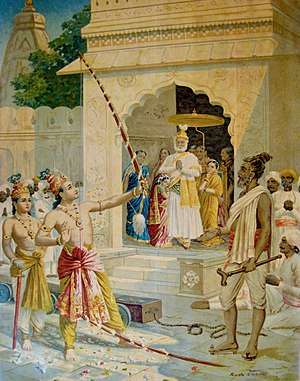
When Sita reaches adulthood, Janaka organizes a Swayamvara in Janakpurdham with the condition that Sita would marry only that person who would be able to string Pinaka, the bow of the god Shiva. Janaka knew that the bow of Shiva was not even liftable, let alone stringable for ordinary mortals, and for selfish people it was not even approachable. Thus, Janaka tries to find the best husband for Sita.
At this time, Vishvamitra had brought Rama and his brother Lakshmana to the forest for the protection of sacrifice. Hearing about this swayamvara, Vishvamitra asks Rama to participate in it and takes Rama and Lakshmana to the palace of Janaka in Janakpur. Janaka is greatly pleased to learn that Rama and Lakshmana are sons of Dasharatha. Next morning, in the middle of the hall, Rama lifts up the bow of Shiva with his left hand, fastens the string taut and breaks the bow in the process. However, another avatar of Vishnu, Parashurama, became really angry as the bow of Shiva was broken. However, he does not realize that Rama is also an avatar of Vishnu, therefore after being informed of this, he apologizes for getting angry. Thus, Rama fulfills Janaka's condition to marry Sita. Later on Vivaha Panchami, a marriage ceremony is conducted under the guidance of Satananda. Rama marries Sita, Bharata marries Mandavi, Lakshmana marries Urmila and Shatrughna marries Shrutakirti.[7]
Exile and abduction
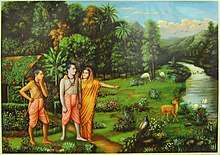

Some time after the wedding, Kaikeyi, Rama's stepmother, compelled Dasharatha to make Bharata king, prompted by the coaxing of her maid Manthara, and forced Rama to leave Ayodhya and spend a period of exile in the forests of Dandaka and later Panchavati. Sita and Lakshmana willingly renounced the comforts of the palace and joined Rama in exile. The Panchavati forest became the scene for Sita's abduction by Ravana, King of Lanka. Ravana kidnapped Sita, disguising himself as a mendicant, while Rama was away fetching a golden deer to please her. Some versions of the Ramayana describe Sita taking refuge with the fire-god Agni, while Maya Sita, her illusionary double, is kidnapped by the demon-king. Jatayu, the vulture-king, tried to protect Sita but Ravana chopped off his wings. Jatayu survived long enough to inform Rama of what had happened.[18]
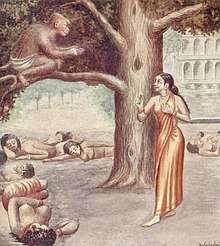
Ravana took her back to his kingdom in Lanka and Sita was held as a prisoner in one of his palaces. During her captivity for a year in Lanka, Ravana expressed his desire for her; however, Sita refused his advances and struggled to maintain her chastity. Hanuman was sent by Rama to seek Sita and eventually succeeded in discovering Sita's whereabouts. Sita gave Hanuman her jewellery and asked him to give it to her husband. Hanuman returned across the sea to Rama.[18]
Sita was finally rescued by Rama, who waged a war to defeat Ravana. Upon rescue, Rama makes Sita undergo a trial by fire to prove her chastity. In some versions of Ramayana, during this test the fire-god Agni appears in front of Rama and attests to Sita's purity, or hands over to him the real Sita and declares it was Maya Sita who was abducted by Ravana.[18] The Thai version of the Ramayana, however, tells of Sita walking on the fire, of her own accord, to feel clean, as opposed to jumping in it. She is not burnt, and the coals turn to lotuses. After proving that Sita is still pure, she returns to Ayodhya. But the citizens of Ayodhya don't accept Sita and says that she is impure, and Ram has to forcefully send Sita against his wish. After 12 yrs he goes back to Sita and asks her to come back to Ayodhya. But Sita denies and says Bhumi to take her inside herself. Sita goes inside the earth and gives her sons to Rama.
The life of Sita after second exile and the reason of exile according to mythology
This section is not a part of the original Valmiki Ramayan, but is a part of Uttar Ramayan.
The couple came back to Ayodhya, where Rama was crowned king with Sita by his side.
While Rama's trust and affection for Sita never wavered, it soon became evident that some people in Ayodhya could not accept Sita's long captivity under Ravana. During Rama's period of rule, an intemperate washerman, while berating his wayward wife, declared that he was "no pusillanimous Rama who would take his wife back after she had lived in the house of another man". This statement was reported back to Rama, who knew that the accusation against Sita was baseless.
Sita upon hearing about this incident knew that it would bring disgrace to the entire clan and hence decided to go and live in the forest. Thus Sita was forced into exile a second time. Sita, who was pregnant, was given refuge in the hermitage of Valmiki, where she delivered twin sons named Kusha and Lava.[7] In the hermitage, Sita raised her sons alone, as a single mother.[19] They grew up to be valiant and intelligent and were eventually united with their father. Once she had witnessed the acceptance of her children by Rama, Sita sought final refuge in the arms of her mother Bhūmi. Hearing her plea for release from an unjust world and from a life that had rarely been happy, the Earth dramatically split open; Bhūmi appeared and took Sita away.(Abounding of Devi Sīta appears in Uttara Kānda which is considered by some people as later added kanda).
Sita's exile during her pregnancy was because of a curse during her childhood.[20] According to Padma-puran, Sita had caught a pair of divine parrots which were from Valmiki's ashram when she was young. The birds were talking about story of Sri Ram heard in Valmiki ashram which intrigued Sita. She has the ability to talk with animals. The female bird was pregnant at that time. She requested Sita to let them go and return from Valmiki's Ashram as they knew only up to their marriage but Sita only allowed her male companion to fly away but female parrot died because of separation from her companion. As a result, the male bird cursed Sita that she would suffer a similar fate of being separated from her husband during pregnancy. The male bird was reborn as the washerman.
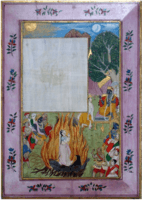 Sita's fire test
Sita's fire test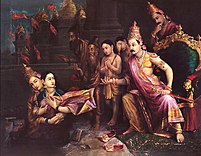 Sita returns to her mother, the Earth, as Sri Rama, her sons, and the sages watch in astonishment.
Sita returns to her mother, the Earth, as Sri Rama, her sons, and the sages watch in astonishment. Rama and Sita from Uttara-Kanda.
Rama and Sita from Uttara-Kanda.
Speeches in the Ramayana
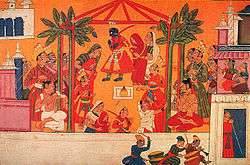
While the Ramayana mostly concentrates on Rama's actions, Sita also speaks many times during the exile. The first time is in the town of Chitrakuta where she narrates an ancient story to Rama, whereby Rama promises to Sita that he will never kill anybody without provocation.
The second time Sita is shown talking prominently is when she speaks to Ravana. Ravana has come to her in the form of a mendicant and Sita tells him that he does not look like one.
Some of her most prominent speeches are with Hanuman when he reaches Lanka. Hanuman wants an immediate union of Rama and Sita and thus he proposes to Sita to ride on his back. Sita refuses as she does not want to run away like a thief; instead she wants her husband Rama to come and defeat Ravana to save her.[21]
Jain version
Sita was the daughter of king ‘Janak’ and queen ‘Videha’ of ‘Mithalapuri’. She had a brother named ‘Bhamandal’ who was kidnapped soon after his birth by a deity due to animosity in previous life. He threw him in a garden of ‘Rathnupur’ where he dropped in the arms of the king ‘Chandravardhan’ of Rathnupur. The king and queen brought him up as their own son with lot of love and care. It turns out that Ram & Sita get married due to Bhamandal and in the course of events Bhamandal realises that Sita is his real sister. It is then that he meets his birth parents.
Symbolism
_LACMA_AC1999.127.45.jpg)
A female deity of agricultural fertility by the name Sita was known before Valmiki's Ramayana, but was overshadowed by better-known goddesses associated with fertility. According to Ramayana, Sita was discovered in a furrow when Janaka was ploughing. Since Janaka was a king, it is likely that ploughing was part of a royal ritual to ensure fertility of the land. Sita is considered to be a child of Mother Earth, produced by union between the king and the land. Sita is a personification of Earth's fertility, abundance, and well-being.
Portrayal
Hindu tradition reveres Sita. She has been portrayed as an ideal daughter, an ideal wife and an ideal mother in various texts, stories, illustrations, movies,[22] and modern media. Sita is often worshipped with Rama as his consort. The occasion of her marriage to Rama is celebrated as Vivaha Panchami.
The actions, reactions, and instincts manifested by Sita at every juncture in a long and arduous life are deemed exemplary. Her story has been portrayed in the book Sitayanam.[23] The values that she enshrined and adhered to at every point in the course of a demanding life are the values of womanly virtue held sacred by countless generations of Indians.
Temples
Although Sita's statue is always kept with Rama's statue in Rama temples, there are some temples dedicated to Sita:
- Janaki Mandir, located at Janakpur, Nepal
- Sita Mai Temple, situated in Sitamai village in the Karnal district of Haryana, India
- Sita Kund, Punaura Dham, situated in Sitamarhi District in Bihar, India
- Seetha Devi Temple, Pulpally in the Wayanad district, Kerala, India
- Seetha Amman Temple, Nähe Nuwara Eliya, Sri Lanka
- Sita temple, Phalswari, Pauri district, Uttarakhand (Proposed)[24]
- Janaki Mandir of Janakpur, Nepal is a center of pilgrimage where the wedding of Sri Rama and Sita took place and is re-enacted yearly as Vivaha Panchami.
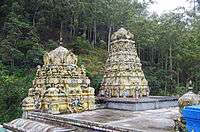 Seetha Amman Kovil, Nähe Nuwara Eliya, Sri Lanka.
Seetha Amman Kovil, Nähe Nuwara Eliya, Sri Lanka.
In Popular Culture
Films
| Films | Played by |
|---|---|
| Lanka Dahan (1917) | Anna Salunke |
| Sita Kalyanam (1934) | S. Jayalakshmi |
| Ram Rajya (1943) | Shobhana Samarth |
| Rambaan (1948) | |
| Ramayan (1954) | |
| Sampoorna Ramayanam (1958) | Padmini |
| Sampoorna Ramayana (1961( | Anita Guha |
| Seeta Rama Kalyanam (1961) | Geetanjali |
| Indrajeet (Sati Sulochana) (1961) | Rajasree |
| Lava Kusa (1963) | Anjali Devi |
| Ram Rajya (1967) | Bina Rai |
| Sita Kalyanam (1976) | Jaya Prada |
| Bajrangbali (1976) | Moushumi Chatterjee |
| Sri Rama Pattabhishekam (1978) | Sangeeta |
| Ramayana: The Legend of Prince Rama (1992) | Edie Mirman (English version voice) |
| Namrata Sawhney (Hindi version voice) | |
| Ramayanam (1996) | Smitha Madhav |
| Lav Kush (1997) | Jaya Prada |
| Raavanan (2010) | Aishwarya Rai Bachchan (Based on Sita's character) |
| Ramayana: The Epic (2010) | Juhi Chawla (voice) |
| Sri Rama Rajyam (2011) | Nayanthara |
Television
| TV Series | Played by | Channel | Country |
|---|---|---|---|
| Ramayan (1987 TV series) | Deepika Chikhalia | DD National | India |
| Luv Kush | |||
| Bharat Ek Khoj | Pallavi Joshi | ||
| Jai Hanuman (1997 TV series) | Shilpa Mukherjee / Meenakshi Gupta | DD Metro | |
| Vishnu Puran (TV series) | Reena Kapoor | Zee TV | |
| Ramayan (2002 TV series) | Smriti Irani | ||
| Jai MahaLaxmi Maa | Preeti Puri | DD Metro | |
| Ramayan (2008 TV series) | Debina Bonnerjee | NDTV Imagine | |
| Raavan (TV series) | Namrata Thapa | Zee TV | |
| Devon Ke Dev...Mahadev | Rubina Dilaik | Life OK | |
| Ramayan (2012 TV series) | Neha Sargam | Zee TV | |
| Siya Ke Ram | Madirakshi Mundle | Star Plus | |
| Sankatmochan Mahabali Hanuman | Deblina Chatterjee | Sony TV | |
| Vikram Betaal Ki Rahasya Gatha | Charu Mehra/Ravneet Kaur | &TV | |
| Ram Siya Ke Luv Kush | Shivya Pathania | Colors TV | |
| RadhaKrishn | Mallika Singh | Star Bharat | |
| Paramavatar Shri Krishna | Hunar Hali | & TV |
See also
- Amba
- Seetha kalyanam
- Sita Sings the Blues
- Siya Ke Ram
Notes
References
- https://m.telegraphindia.com/states/bihar/rs-48-5-crore-for-sita-s-birthplace/cid/1440819
- "Hot spring hot spot - Fair begins on Magh full moon's day". www.telegraphindia.com. Retrieved 22 December 2018.
- "Sitamarhi". Britannica. Retrieved 30 January 2015.
- "History of Sitamarhi". Official site of Sitamarhi district. Archived from the original on 20 December 2014. Retrieved 30 January 2015.
- http://sacredsites.com/asia/nepal/janakpur.html
- Sutherland, Sally J. "Sita and Draupadi, Aggressive Behavior and Female Role-Models in the Sanskrit Epics" (PDF). University of California, Berkeley. Retrieved 1 August 2012.
- Swami Parmeshwaranand (1 January 2001). Encyclopaedic Dictionaries of Puranas. Sarup & Sons. pp. 1210–1220. ISBN 978-81-7625-226-3. Retrieved 31 July 2012.
- "The haughty Ravana". The Hindu. 10 April 2014. ISSN 0971-751X. Retrieved 2 July 2020.
- Gopal, Madan (1990). K.S. Gautam (ed.). India through the ages. Publication Division, Ministry of Information and Broadcasting, Government of India. p. 78.
- Suresh Chandra (1998). Encyclopaedia of Hindu Gods and Goddesses. Sarup & Sons. pp. 304–. ISBN 978-81-7625-039-9. Retrieved 1 August 2012.
- Heidi Rika Maria Pauwels (2007). Indian Literature and Popular Cinema: Recasting Classics. Routledge. pp. 53–. ISBN 978-0-415-44741-6. Retrieved 31 July 2012.
- "https://m.dailyhunt.in/news/india/english/wittyfeed+india-epaper-witty/12+mythological+facts+about+sita+that+most+of+us+don+t+know-newsid-72197999"
- "Bihar times". Archived from the original on 19 October 2014.
- "Narendra Modi Cancells his visit to Sita's birthplace Janakpur, Nepal".
- "Birthplace of Sita in Janakpur, Asia Travels".
- "The Story of Mother Sita the consort of Rama". Salagram.net. Archived from the original on 30 May 2012. Retrieved 18 March 2012.
- Singaravelu, S (1982). "Sītā's Birth and Parentage in the Rāma Story". Asian Folklore Studies. University of Malaya, Kuala Lumpur, Malaysia. 41 (2): 235–240. doi:10.2307/1178126. JSTOR 1178126.
- Mani pp. 720-3; Mani, Vettam (1975). Puranic Encyclopaedia: a Comprehensive Dictionary with Special Reference to the Epic and Puranic Literature. Motilal Banarsidass Publishers. ISBN 978-0-8426-0822-0.
- Bhargava, Anju P. "Contemporary Influence of Sita by". The Infinity Foundation. Archived from the original on 13 July 2012. Retrieved 31 July 2012.
- "Padma-puran pdf file" (PDF). 1 October 2018. Retrieved 1 October 2018.
- Valmiki, Ramayana. "Sundarkanda, sarga 37". www.valmiki.iitk.ac.in. IIT Kanpur.
- Dhar, Aarttee Kaul. "Ramayana and Sita in Films and Popular Media:The Repositioning of a Globalised Version". Cite journal requires
|journal=(help) - "Sitayanam – A Woman's Journey of Strength" by Anju P. Bhargava Archived 1 January 2009 at the Wayback Machine
- Singh, Kautilya (12 November 2019). "Uttarakhand set to come up with a massive Sita temple". The Times of India. Retrieved 13 November 2019.
Bibliography
- Jain, Pannalal (2000). Hiralal Jain, A.N. Upadhaye (ed.). Ravishenacharya's Padmapurana (in Hindi) (8th ed.). New Delhi: Bhartiya Jnanpith. ISBN 978-81-263-0508-7.CS1 maint: ref=harv (link)
- Iyengar, Kodaganallur Ramaswami Srinivasa (2005). Asian Variations In Ramayana. Sahitya Akademi. ISBN 978-81-260-1809-3.CS1 maint: ref=harv (link)
- Das, Sisir Kumar (2005). A History of Indian Literature, 500-1399: From the Courtly to the Popular. Sahitya Akademi. p. 124. ISBN 978-81-260-2171-0.CS1 maint: ref=harv (link)
External links
| Wikimedia Commons has media related to Sita. |
| Wikiquote has quotations related to: Sita |
- Sita Kalyanam in the Valmiki Ramayana
- . New International Encyclopedia. 1905.
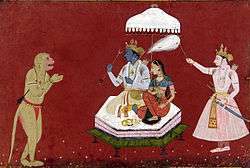
.jpg)

